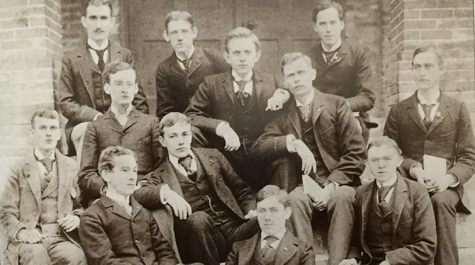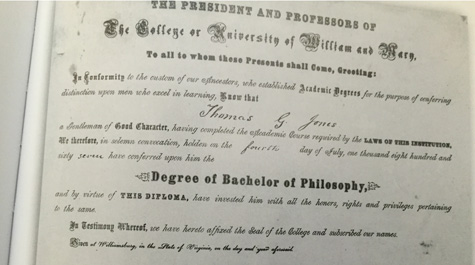What a day! Commencement, July 4 celebrated together
Escorted by local militia, they processed down Duke of Gloucester Street to Bruton Parish Church, where townspeople were gathered, anxiously awaiting their arrival.
That’s how the Board of Visitors, the president, faculty and students of William & Mary spent the Fourth of July – and Commencement – for much of the 19th century.
That’s right, the university packaged the two celebrations, with few exceptions. One year, the Fourth fell on a Sunday, so Commencement was held the following day. A review of records shows that, starting in 1891 (July 3), Commencement was moved away from July 4 to late June and gradually to the position it holds on the calendar today.
On Independence Day/Commencement, the schedule of the day was typically as follows: at approximately 10 a.m., the president would recite a prayer, a student would read the Declaration of Independence – a tradition that continued until 1967-- the graduates would give speeches and diplomas would be distributed.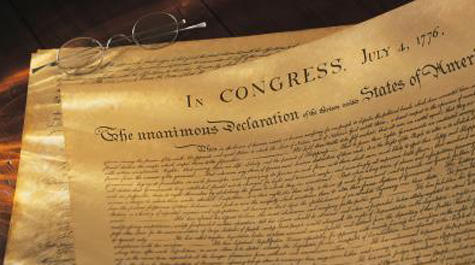
In a review of the 1828 ceremony at Bruton Church, it was noted that the College had erected in the church “a Scaffold sufficiently large to accommodate the (Board of) Visitors, the Faculty, and the graduates.”
When it came to oration, it was present in abundance. In 1809, graduate Samuel Myers’ address to his “fellow citizens,” the original of which is housed in the university’s Special Collections section, was 12 pages long and written on both sides of the paper. Myers was the son of Moses and Elizah Judah Myers and grew up in Norfolk. The family’s home is today the oldest Jewish home in America open to the public as a museum.
The speech delivered to students in 1859 by Hugh Blair Grigsby, Esq., was 15 pages long.
The program from the 1832 “Collegiate Exercises,” as they were called, included orations on “the day,” “the present prospects of our country,” “the effects of enterprise on the condition of society,” “the glory of ancient Greece” and “the nature and value of happiness.”
There followed a eulogy of Patrick Henry by John S. Stubbs before a return to orations on “the influence of William & Mary College on the literary and political history of our country,” “the ruins of time and the mutability of empires,” “the benevolence of the deity, as displayed in the works of creation” and “the love of country.”
Then came the awarding of degrees, the baccalaureate address and a concluding prayer.
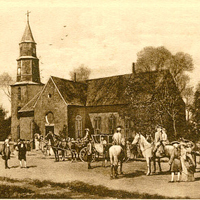 How long did all of this take? Obviously, it varied from year to year – in 1860, for example, only J. Filmer Hubbard and Thomas Jefferson Stubbs received diplomas. The 1836 ceremony began at 10 and, according to a letter in the Richmond Enquirer “between two and three o’clock ... the students, generally, and some other young men, went to the College, to partake of an excellent dinner prepared at the Brafferton by Mr. Apperson, Steward of the Institution.”
How long did all of this take? Obviously, it varied from year to year – in 1860, for example, only J. Filmer Hubbard and Thomas Jefferson Stubbs received diplomas. The 1836 ceremony began at 10 and, according to a letter in the Richmond Enquirer “between two and three o’clock ... the students, generally, and some other young men, went to the College, to partake of an excellent dinner prepared at the Brafferton by Mr. Apperson, Steward of the Institution.”
Little changed with time. The 1857 Commencement program listed eight orations, targeting ambition, colleges, learned professions of the 19th century, science and religion and the spring tide of life.
Independence Day/Commencement was one of celebration for the entire town – and often beyond. People traveled from other states to attend. In what appears to have been a long-time annual occurrence, the president of the university issued a pronouncement inviting everyone to come.
For example, W&M President James Madison, first bishop of the Diocese of Virginia of the Episcopal Church in the United States and cousin to the American President of the same name, posted the following in a June 1796 edition of the Virginia Gazette:
Notice is hereby given that public examination of the classes in the different schools will commence 4th of July. – J. Madison, president.
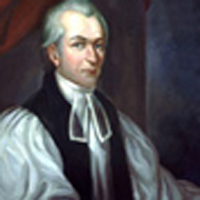 Also, according to the Virginia Gazette, in his 1799 prayer to open the ceremony, Madison “with a fervor worthy of the cause, returned thanks to the God of Battles for the establishment of our independence, and implored the perpetuity of it.”
Also, according to the Virginia Gazette, in his 1799 prayer to open the ceremony, Madison “with a fervor worthy of the cause, returned thanks to the God of Battles for the establishment of our independence, and implored the perpetuity of it.”
That same year, the Gazette continued, Mr. Bernard Carter “with great propriety, delivered a eulogy on those who fell in the American War, and on him who, under Providence, led us to victory. The intervals between orations were filled with martial music.
“Capt. Ambler’s troop of horse and Capt. Lightfoot’s light Infantry then fired feux de joye, and performed their military exercises with an activity inspired by the day. . .”
Those visiting the Colonial Capital seemed impressed by what they saw. Take this excerpt of a letter to a Richmond newspaper from a “gentleman in Williamsburg.” He attended Commencement in 1812, less than one month after the United States declared war on the United Kingdom of Britain, the Canadas, Spain and an Indian confederacy under the leadership of Tecumseh.
“The spirit of liberty and independence seemed to have infused itself into the breast of every citizen of this place, and to have excited a joyous exultation at the return of this glorious day,” he wrote. “This exultation was exhibited by some in the splendour of a military parade; by others in feasting, and by many in the expression of noble political sentiments thro’ this medium of Toasts . . . I did not join in their glee, but feasted in a calm observation of their enjoyments, and of the handsome performances of the students.”
After quoting President John Bracken’s prayer verbatim − Bracken gave it to him when they met on the street after the ceremony − and praising the many orations as “splendid,” “enthusiastic and patriotic,” “most logical” and “elegant,” the writer states, “I saw in our young countrymen the germ of talents, a progressed improvement in science, and a virtuous patriotic sentiment which promise a strong support of our grand political fabric.”














